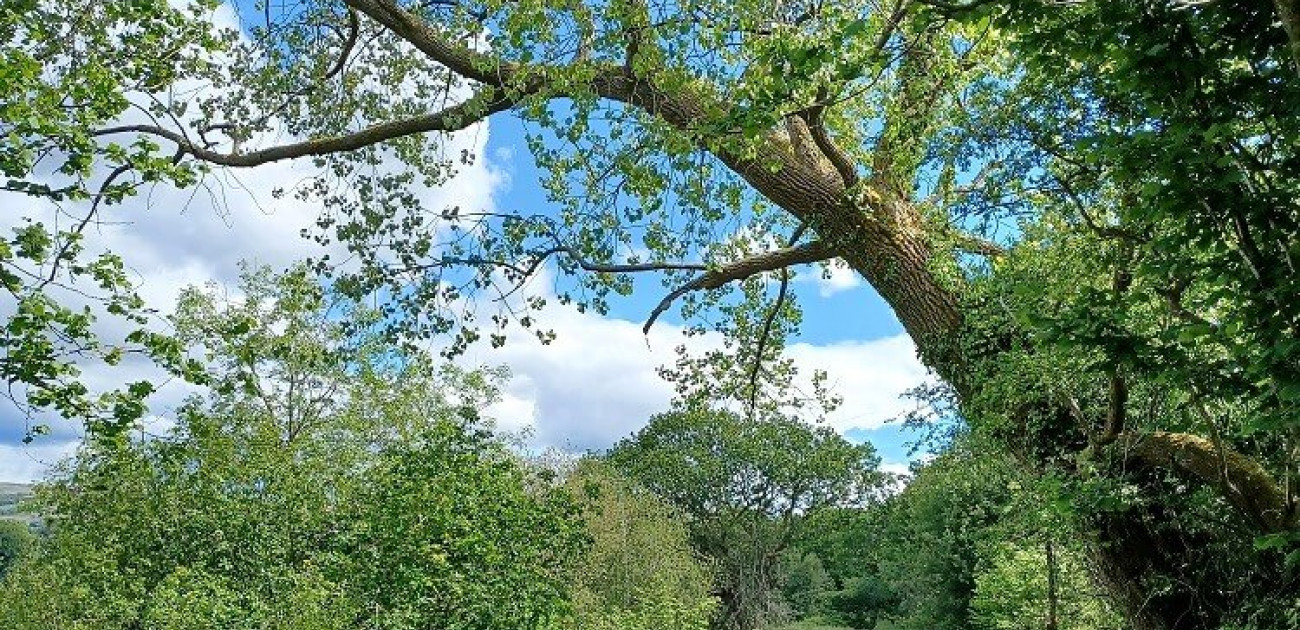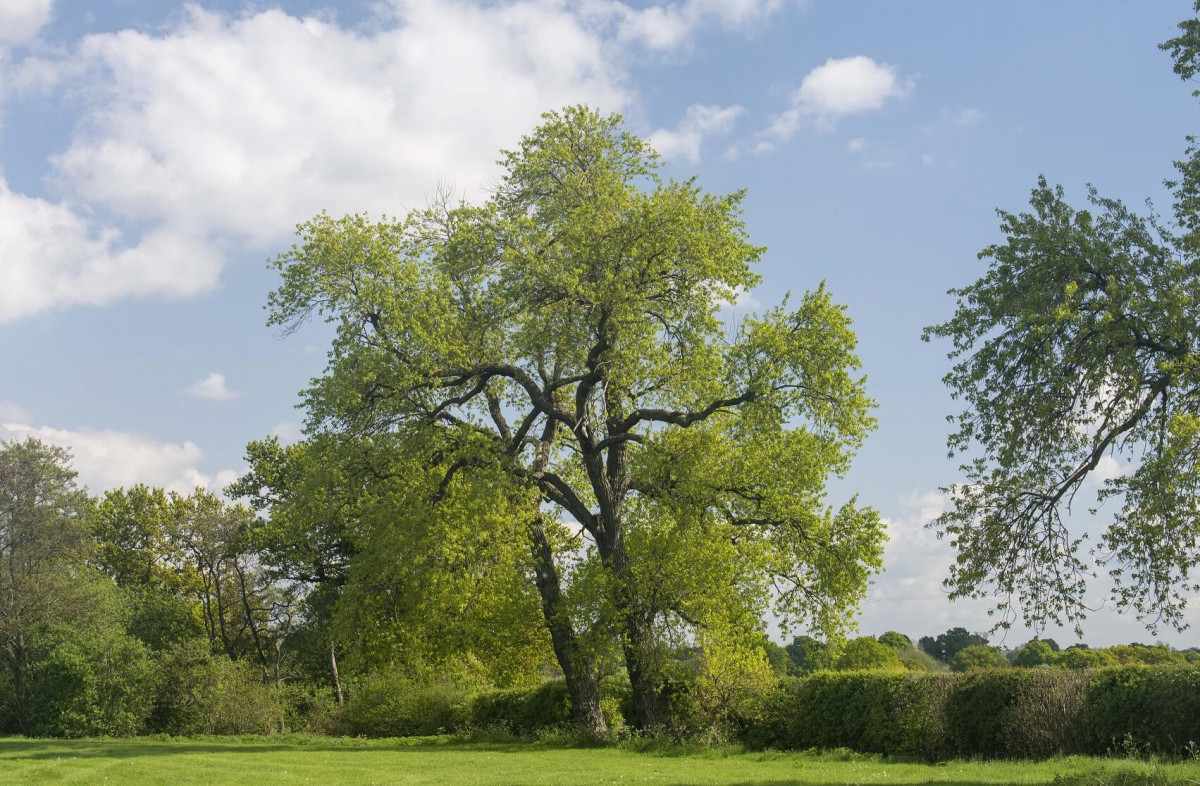17 November 2022
The Leaning Poplar – Is It A Hybrid Or A Native Black Poplar?
There's a poplar trees leaning over from our boundary hedge onto a neighbour's land and it needs to come down for safety. We were concerned it could be a black poplar, so ran some DNA tests to determine whether it was. It is a hybrid poplar.

We have a tree that is hanging over from a bank into our neighbour’s land. It is unsafe, but we have been told it was a black poplar (Populus nigra) with conservation value, so we would need to think about protecting it. We had no idea whether it was or wasn’t, so we sent samples for DNA analysis at Forest Genetics. The result: it’s a hybrid poplar, not a native black poplar.
I have to admit I don’t know my Alnus from my Ulmus, but I am learning the more trees I see and touch. And we have had some fun with one of our many trees – a poplar that is leaning over our neighbour’s land and needs to come down or be made safe as it will likely keel over at some point.
Two of our consultants (a conservationist and a botanist) said it is a black poplar and our forester reckoned it is more likely a hybrid poplar. What to do because black poplars are rare in Wales and have conservation value? I am not sure whether poplars are the best for biodiversity or whether it is just that they are rare; that having been said, poplar species rank sixth in UK for associated insects, such as the poplar hawk moth, even if it's one-third of those linked with oaks and willows.
Fortunately, Forest Research offers a service that will analyse the DNA of fresh samples from putative black poplars for a small fee. Actually, it is a reasonably priced service at £72 per samples. Trust the science is our motto.
As the tree is precarious, I asked John Andrews from Wildwoods Arboriculture to take samples for us and send them off to Edinburgh for analysis.
The brief from Stuart A’Hara of Forest Genetics was to send him a small cutting (10 – 20 cm) with some green healthy leaves from the tree for analysis, then they would extract DNA from these and carry out two tests: (i) a screening test is run to see if the tree is a native black poplar and not a first generation hybrid poplar; (ii) if it is a native black poplar, then a DNA fingerprint is generated for the tree using DNA markers called microsatellite markers, which enables Forest Genetics to drill in further and check the DNA fingerprint of a sample against their database of poplars from previous tests (over 1,000 trees from the last 10 years) and see whether the tree is a common clone. Most poplars are hybrids, and a large chunk of genuine black poplars are clones from a widely planted Manchester tree.
Samples were collected 11th October by John Andrews and received the next day in Scotland.
Initial visuals by Stuart A’Hara suggested it was probably a hybrid: ‘on first glance, it does look like a hybrid poplar to me, based on lack of hairs on the petiole, over-all leaf shape, the hooked leaf margins and the glands present either side of the petiole.’
He extracted the DNA then ran a test against a standard black poplar profile to check whether it was a hybrid or not. In this test, the allele sizes generated with 10 microsatellite markets are determined and compared to known native black poplars. Four of these were in a size range different from native black poplars. So, the conclusion is that it is a first-generation hybrid poplar of black poplar (P. nigra) crossed with American eastern cottonwood (P. deltoides). These crossed by tree breeders and nurseries because the hybrid is a faster growing tree and shows good hybrid vigour.
So, this hedgerow poplar was probably planted around 70 years ago to stabilise the bank as hybrid clones were trendy in the 1950s. Nevertheless, it is odd as it is a single tree and there are no other poplars, hybrid or otherwise, amongst the many thousands of trees we have. Most are self-sown natives like sessile oak, holly, birch, grey willow rather than planted trees, so this hybrid poplar remains a curiosity. Perhaps, it came within a bundle of other trees or is just one of those random things that happens, a gift or a cheap tree bought at market.
What to do? It gives us a sense of relief in that we can dismantle this unsafe poplar, then the brash and trunk will be laid back our wood to decay over time. We will take a few cuttings and plant these out to where the original tree was, so keeping this point of woodland historical interest, even if it has less conservation value than originally hoped.
Going forward, we have sourced native Welsh black poplar from Habitaid, and have bought a few male and female trees. We are going to plant these near Garnant burn where a small feeder gut connects into the burn. This will give us some conservation interest, even if these will be planted rather than local black poplars that were here already. After all, we are still in the initial restoration part of our woodland creation.
Black poplars have heavily-textured, dark bark, almost black, but its epithet 'black' may be more to contrast it with the white poplar and the grey poplar. Its wood is almost white and is not much used these days, but in the past was used for packing cases or baskets. The black poplar is a large, heavy-limbed tree, sparsely branched that tends to lean over under the weight of its heavy limbs, like our poplar is demonstrating. This gives it an unkempt if beautiful feel. Its leaves are triangular, opening light brown before going to a deep green on top and paler underneath. The leaves turn yellow in autumn.
The male catkins of the black poplar are attractive and hang like lambs' tails in March before the leaves unfold - their anthers are crimson until they show their pale-yellow pollen. The female catkins, which are on separate, even rarer trees, are longer, with stout greenish-white stigmas. The capsules fall in early June but seldom contain seed and most poplar trees propagated by cuttings.
Indeed, black poplars are rare because agricultural improvements have drained the water meadows that poplar seeds need to germinate and become established. Also, they are dioecious, so need male and female trees close by each other to enable wind-blown pollination to happen. But there are very few female black poplars - maybe no more than c. 600 trees - in the whole of the UK, so that further reduces the chances of natural reproduction.

I hope that what this does show is how we are in a process of getting to know our land. We are using scientific methods as much as possible to give us independent, expert information on what we have bought, so we have had habitat surveys done, tree surveys done, animal species surveys done by external consultants, as well as making some of our own amateur, ad hoc observations. These cover the observable biology of the land.
Also, we have done our own tests, and have set up specialist gear, to understand the physical parameters of the land - that's weather, water properties, groundwater flows, soil texture, pH and chemistry.
Then, alongside this, we have been trying to understand the history of the land, which is challenging but revealing and has included some real surprises. There is a long way to go - a lifetime - but we're starting to pull these together to give us a foundation, on which to build a way forward.
We are perhaps taking a slower path than others would want us to, but we don't want to rush into doing anything that's wrong - indeed, some things are not the way we'd have done it, which may partly be because of too much haste and not enough understanding about the land. A few years is really too short a time to learn about the land, so patience is what we need, which is at times very difficult as we don't want to pause and hold back, but to get on with things. As the information comes through, we are considering it in and of itself, and against forestry and environmental practice, to see how this can be shaped into a plan.
So, we're following the advice given to Paul Atreides, or MaudD'ib, from 'Dune' (the book rather than the film); "She [Reverend Mother Gaius Helen Mohiam] said a good ruler has to learn his world's language, that it's different for every world. And I thought she meant they didn't speak Galach or Arrakis, but she said that wasn't it at all. she said she meant the language of the rocks and growing things, the language you don't hear just with your ears."
This doesn't mean we're doing nothing, but we are not doing a lot. This low level of activity, though, is a choice that we have made, a very conscious decision because nature can do a lot of what we want by itself, without our interference and a damn sight better than we would do anyway. We don't know better than the biodiversity that's already there, and our overriding theme is to go with the grain of what the environment wants to do. The hard bit is hearing what nature, what the land, is telling us, we're having to learn its language.
Over the next few months, I will try and explain what we have found out and then some of the thoughts we are developing.




